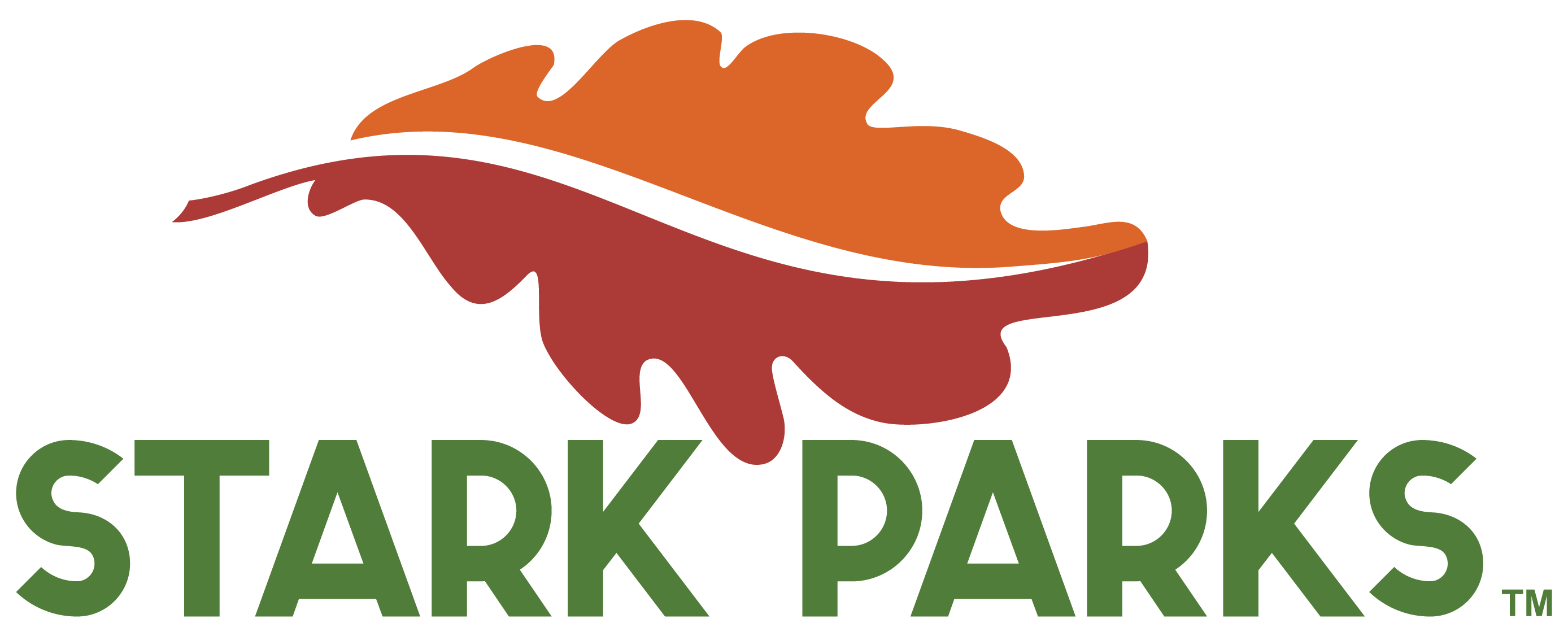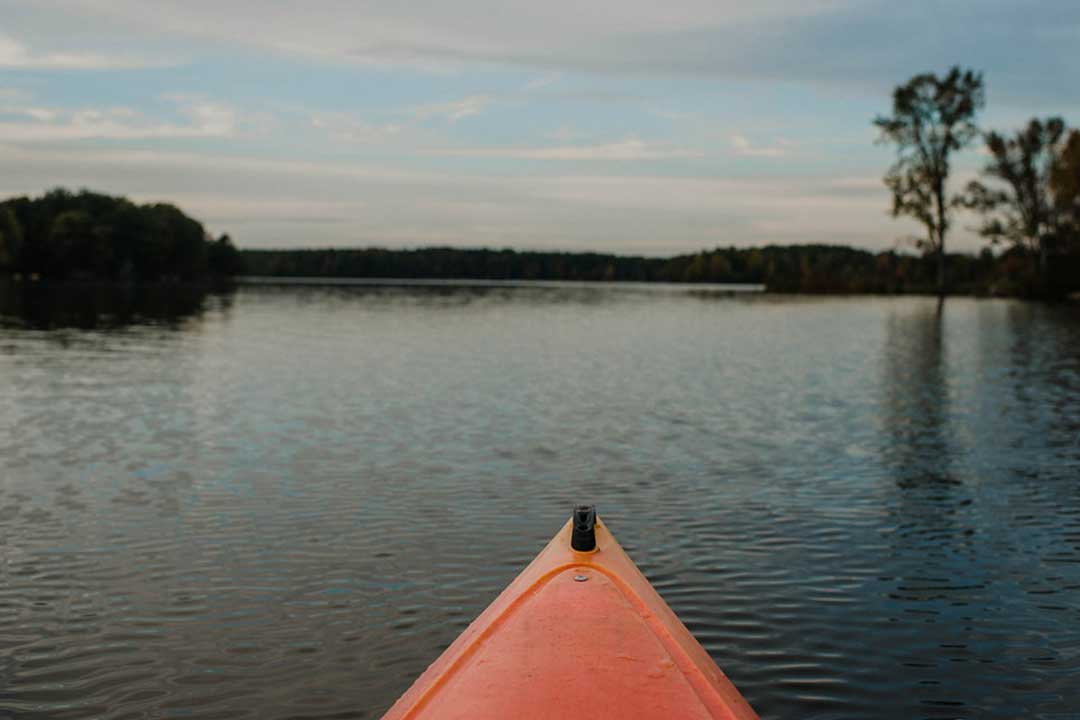Walborn Reservoir Eagle Nest Report
We hope you enjoy the observations of eagle watching volunteers and invite you to stop by the nest site located on the west side of Walborn Reservoir at 13600 Marlboro Ave. NE, Alliance.
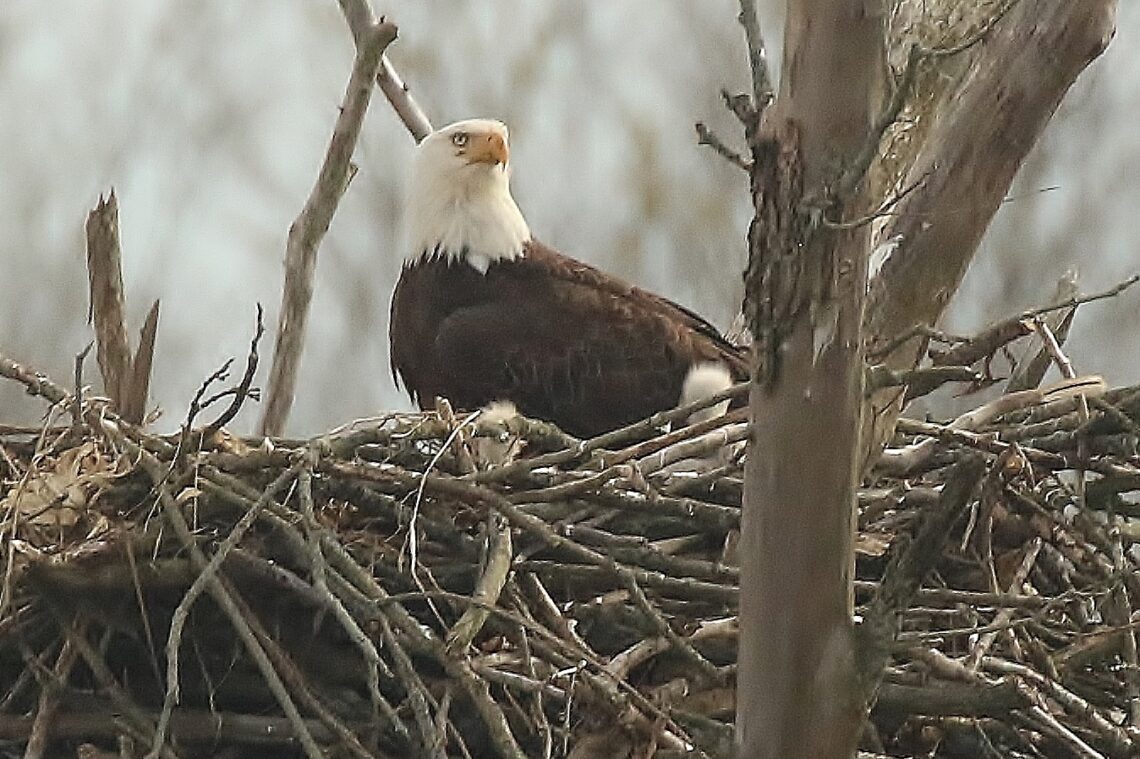
April 9, 2024- A hatch has occurred and two eaglets have been spotted. This is the first hatch at the site since 2021, first hatch in the new nest location, and the first offspring from this mating pair of adults. We invite you to Walborn Reservoir this spring and summer to enjoy seeing the nest and activity in and around it in person. Photo by Barry McClung.
Feb. 27, 2024- Recent observations show that the eagles are staying around the new nest site visible from the peninsula located off the small parking area. Some signs match those of egg incubation, time will tell what happens over the next few weeks and if eaglets eventually pop up in the nest. Volunteers are typically there Tuesday to Friday and Sundays in the later afternoon from 4:30 to 6:30 p.m. with their spotting scopes set up if the weather permits.
June 10, 2023– Recent observations show that the eagles are staying around the area and often arrive around dusk to a new nest site located within view over the water from the current parking area. The more time they spend in and around here is a good sign for a longer term stay.
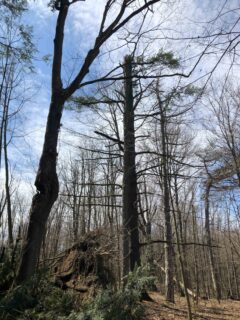 April 3, 2023– It was anticipated that the first week of April would bring news of a hatch at the nest, but things changed with the recent storms and high winds. The March 25th high winds might have damaged a part of the nest and the April 1st high winds took the entire top of the tree and nest down to the ground. It is unknown what the future will hold for the two adults staying in the area. We can only hope that they build a nest around Walborn Reservoir somewhere and we can continue to appreciate the views they offer. In the meantime, our volunteer eagle watchers will keep observations and reports coming in and we’ll share future updates here.
April 3, 2023– It was anticipated that the first week of April would bring news of a hatch at the nest, but things changed with the recent storms and high winds. The March 25th high winds might have damaged a part of the nest and the April 1st high winds took the entire top of the tree and nest down to the ground. It is unknown what the future will hold for the two adults staying in the area. We can only hope that they build a nest around Walborn Reservoir somewhere and we can continue to appreciate the views they offer. In the meantime, our volunteer eagle watchers will keep observations and reports coming in and we’ll share future updates here.
March 3, 2023- Winter observations have been fairly regular and courtship and mating appear to have started during the last week. It is believed that this pair of eagles were at the nest most of 2022. If all goes has planned, a hatch should occur around the first or second week of April 2023!
May 15, 2022-It’s certainly been an interesting year for our Eagles. After the loss of eggs and all that happened, there was hope for a second clutch of eggs. For a while we had two adults who spent time together and gave us hope. However, the last 4-5 days we haven’t been seeing those two adults together. So, it’s unlikely that we’ll have any additional eggs. With mother nature things aren’t predictable.
April 18, 2022-More twists and turns at the site including two juvenile eagles and one adult eagle nearing maturity with a dirty white head started the month off. Now, a second mature adult is present and bonding appears to be happening between the two adults. Volunteer Bob B. may have said it best. “We can’t explain everything that happened this year already. It will be interesting to see what happens from here on out!”
March 29, 2022-As in previous years, things can be normal one day at the nest and very different the next. In the past week, eagle volunteers have observed long periods from 20 minutes to an hour where no adult is present at the nest. This causes concern for the viability of the eggs, especially with colder temperatures on those days. Then, a new adult appears to be at the nest site which leads to more questions if the eggs will continue to be cared for. Check back here for more observations over the next few weeks!
March 1, 2022-Observations at the Walborn Eagle Nest indicate there are eggs in the nest and incubation and exchanges between the adult eagles occurring. An expected hatch date of around April 1 is the best estimate right now.
Aug. 9, 2021-The eagles continue to be elusive and sightings require some good luck and timing. The volunteers have suspended their observation hours for the season at this time.
July 2, 2021-Recent Eagle observations have been sporadic. Since the juveniles have fledged they have been spending increased time away from the nest probably being trained by the parents in catching their own food. Recent reports have observed both the adult and juvenile eagles near Reeder Ave. across from the trailhead. Hopefully they will also continue to spend time in and around the nest.
May 20, 2021-Eagle volunteers report frequent trips in and out by the adults with all three eaglets being well fed and taken care of. The eaglets are growing up fast and already flapping their wings for practice. Volunteers are typically at the nest site on Tues., Thurs, and Sun. from 5 to 7 p.m. and Mon. and Weds. from 3 to 5:30 p.m.
April 1, 2021-Eagle volunteers reported seeing feeding behavior at the Walborn Eagle Nest site. They will keep their scopes and cameras ready to see how many heads pop up during feeding for an eaglet count. We believe a hatch happened around March 31 or April 1. Three tiny heads in the nest have been spotted at one time! The adults will get more active flying in and out bringing food and protecting the young. This increased activity should continue for several weeks and is a tough job for the adults to bring in plenty of food for the new eaglets and for themselves.
The plumage of the young will go from a fuzzy yellow to a dark brown which will eventually develop some splotchy white coloring as they mature. They will develop the white head and tail at four to five years of age when they become fully mature.
The young stay in the nest 8-14 weeks. They jump and exercise their wings as they grow. They do limb hopping as they mature in preparation for flying which can be haphazard at times.
Please enjoy our Bald Eagles. We are fortunate to have them in Stark County. Volunteers are typically at the nest site on Tues., Thurs, and Sun. from 5 to 7 p.m. and Mon. and Weds. from 3 to 5:30 p.m.
March 1, 2021- It appears incubation is occurring, but every so often there is a head scratching moment. During incubation, an eagle is always at the nest with the egg. On Feb. 27, both eagles were gone for a period of time, came back for about a few minutes and then left again, repeating this several times. On Feb. 28, an eagle was at the nest the entire time.
Eagle watching volunteers believe that egg-laying commenced around Feb. 19, 2021. This means an estimated hatch date will be around March 24, 2021! 2021 marks the first year that this new pair will hopefully raise eaglet(s). Only time will tell how successful they will be. It is a good time to visit the nest and get a glimpse of an eagle!
Feb. 22, 2021-Late Feb. and March are always an exciting time around the eagle nest at Walborn Reservoir. It is around this time of year that we wait and see if the eagles are sitting incubating eggs. This site on Marlboro Ave. has been extremely fortunate to welcome nearly over 25 eaglets into the world over the last 15 years!
Eagle watching volunteers have been stopping by the site just about every day and believe that egg laying commenced around Feb. 19, 2021. This means an estimated hatch date will be around March 24, 2021.
As with most things during the last year, 2020 was an interesting season at the nest as well. Sometime in May, a new adult male eagle appeared at the nest. Based on the feather pattern, it was not the one from previous years or part of the mating pair that hatched two eaglets with only one surviving.
2021 marks the first year that this new pair will hopefully raise eaglet(s). Only time will tell how successful they will be.
Equally as awesome in knowing more about our nation’s symbol and their comeback story in Ohio is the opportunity for people to watch and experience it at the Walborn Reservoir nest site! You don’t have to be an expert in wildlife or conservation to look through a spotting scope or binoculars and observe wildlife!
Nov. 20, 2020– This time of year is usually not an active time at the Eagle nest. The adults are in the area and are preparing for bonding, courtship, mating, egg laying, and rearing the young. Volunteers at the observation deck may stop by infrequently to observe any activity around the nest. Increased activity and reports of nest building around the nest has been observed lately. There may be a different male and this may be related to the recent increase in activity.
Activity is expected to increase during December and January with the adults spending more time together and rebuilding the nest. Please continue to stay a safe distance from others at the observation deck
Sept. 10, 2020- It looks like the lone juvenile has left the nest and probably headed to Lake Erie. The parents remain in the area but may or may not spend much time in or around the nest. Volunteers at the observation deck may stop by infrequently to observe any activity, but do not have set days or times during the fall and winter. We have noticed that the branch to the left of the nest has apparently broken off. That branch had been a favorite roosting spot for the eagles.
Activity is expected to increase during December and January with the adults spending more time together and rebuilding the nest.
Aug. 30, 2020- After looking at comparison photos, we believe the juvenile eagle hanging around the nest is not actually the eaglet from this season. 2020 continues to be a unique year at the nest site.
Aug. 18, 2020- Sightings of the juvenile eagle confirm it is still around. It usually lands in the trees around the nest for short periods before flying off again.
June 24, 2020- It is believed that the first flight by the juvenile eagle occurred on June 12. He or she impressed the volunteers with the in-air flying, the landing wasn’t too impressive though. The next morning it was back in the nest. On June 14, the juvenile was observed in the bushes below the nest. After a few hours it flew up to the nest. Again, as has been the case recently, neither adult came to the nest.
Hopefully with the start of a new breeding season (in December or January) things may return to normal with courtship behavior and the cycle repeating itself once again. Enjoy our Bald Eagles. They are a national treasure!
May 25, 2020- The last two months at the nest have been unique. Unfortunately, only one of the eaglets survived. The reason will never be known for sure. 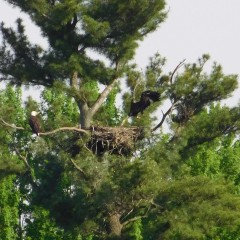 Storms with high winds, a late spring cold snap with snow, or part of a territory battle. The surviving eaglet appears to be doing well and is flapping its wings and should soon be hopping between limbs. Soon after that, it will begin flying and learning to hunt before heading out to live on its own.
Storms with high winds, a late spring cold snap with snow, or part of a territory battle. The surviving eaglet appears to be doing well and is flapping its wings and should soon be hopping between limbs. Soon after that, it will begin flying and learning to hunt before heading out to live on its own.
Sometime in early to mid-May, volunteer eagle watchers noticed that the feather pattern of the male eagle was a little different around the neck area. There was also some feathers missing on the wing that most likely happened from a territory battle or attack. At this point, we believe that the adult male eagle currently at the nest is a new resident and not the one from previous years including the beginning of this season.
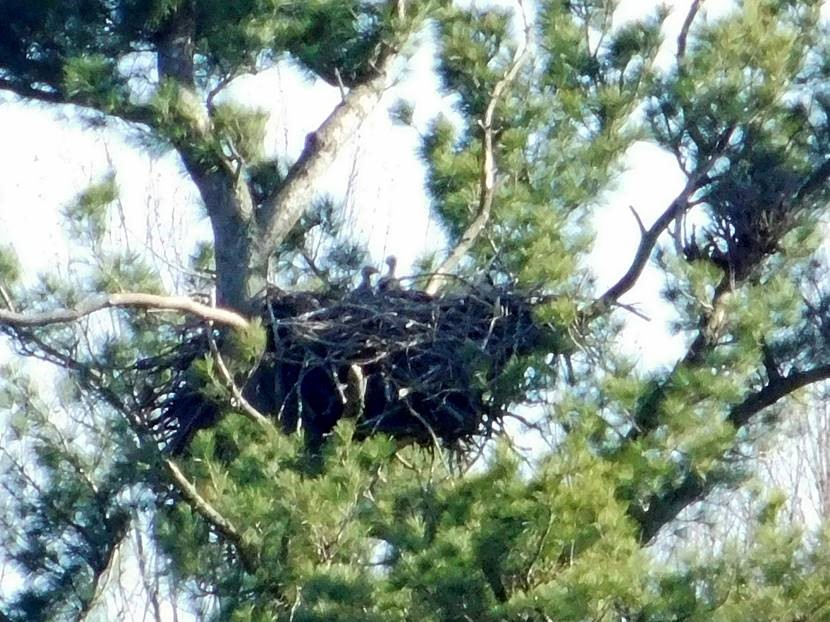 April 1, 2020- Two eaglets have hatched at the nest. Regular feeding continues by the adult eagles with fish coming in several times each day.
April 1, 2020- Two eaglets have hatched at the nest. Regular feeding continues by the adult eagles with fish coming in several times each day.
The Observation Deck and area is open. No more than two people on the deck at the same time and viewing equipment should not be shared. Please use open space along the trail to keep a safe distance while observing.Jan. 13, 2020– 2020 marks the 15th season for the Walborn Eagle Nest. The nest has produced 25 eaglets over the past 14 years and we’re hopeful for another good year.
Eagles will lay one to three eggs. Some research predicts that 50% of the young don’t survive their first year. An average adult eagle is 36″ (head to tail) with a wing span of 7 feet and weighing around 13 lb. They can soar as high as 10,000 feet and fly at 35 mph. Their eye sight is about 8 times better than humans. Their main diet is 75% fish, but they also feed on small animals and carrion.
Activity will increase in the nest as the season goes on. Signs of incubation occur in late Feb. with eggs hatching in late March or early April. I have been watching eagles for 25 years and it is time that I retire as an official eagle watching volunteer with Stark Parks. It has been fun meeting you all and writing these updates. Please keep visiting and enjoying this area and these birds.
Oct. 1, 2019- We had another great nesting season at the Walborn Eagle Nest. For just the second time in history, there were three eaglets in the nest. The production rate continues to be impressive with 25 eaglets in 14 nesting seasons. A lot of this success is due do a great food supply. That is why we also see a lot of Osprey feeding around the reservoir too.
The juveniles from this year are now on their own. A lot of them go to the Western Basin of Lake Erie. There is a larger food supply there and a lot of other young eagles plenty of places to improve their hunting and flying skills. At around three years of age, they may return to within 50 miles of the nesting area they fledged from. At around five years of age, their head and tail will be completely white showing that they are fully mature. They will eventually find a mate and begin looking for a place to build their own nest.
Seeing an eagle at the nest is still very likely. The two adults remain in the area and protect their nest site, often perching in the tree. They will start adding a layer of dried grass in the nest and adding sticks as part of their yearly mating ritual as early as late November, but usually in late January / February is when they really get busy. By the middle of February to early March, we’ll hopefully have signs of eggs in the nest and a hatch in late March to early April. From that time all the way through July, you will be able to see a lot of activity. We hope to see you again in 2020!
July 12, 2019- We are nearing the end of another great year – the 14th season – at the Walborn Eagle nest.
The fledglings will soon leave the area and venture out on their own, probably to the western basin of Lake Erie where they will mingle with other fledglings. There is a larger supply of food there and many dead trees to perch in. They will hone their hunting and flying skills for a couple of years. At around three years of age, they will return to the area that they fledged from and eventually settle within 50 to 100 miles of that area. They receive their white feathers at around 4 ½ to 5 years and eventually pair up with a mate and start their own nest.
The life span of an eagle has greatly increased over the years. Many are living as long as 30 + years, which is awesome considering back in 1979, there were only 4 pairs in the entire Great Lakes region. The 2018 count for Ohio was 286 nesting pairs and 445 eaglets.
Thank you to the Ohio Division of Wildlife for such an awesome job. Many people have seen their first eagle at this location. We are proud to share this experience with so many visitors!
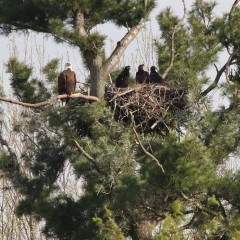
June 13, 2019- It has been another great year at the nest. The eaglets are now fledglings. One flew last Friday evening and the second flew this past Tuesday. They will begin leaving the area in about a month.
The fledglings will continue to build up their strength and watch their parents to learn how to catch their own food. They will probably head to the Western Basin area of Lake Erie and continue to hone their skills. At about three years of age, they generally return to within 50 to 100 miles of their nest site. At around 4.50 to 5 years of age, their heads will turn white. They will pair up and start their own nest at that time.
Being an eagle watching volunteer has been an awesome hobby for me over the past 25 years. I have been blessed with the eagle observation deck to share my passion with many new friends. See you out there!
May 5, 2019- The Walborn Reservoir eaglets are about six weeks old now and are developing their feathers. They will be able to keep themselves warm, mom and dad will still help them. They have a big appetite and are keeping both adults busy catching food for them. It takes an average of one large fish per day for each bird.
They will also eat road kill and small animals along with ducks and geese. The eaglets will start to flap and stretch out their wings soon. As the feathers develop they will lift off from the nest as they flap their wings. They will start to fly between 9 and 13 weeks. They will stay in the area to around 15 weeks of age. During that time, they will watch their parents to learn how to hunt and catch food. We usually can count on them being around until late August.
This is the 14th year for this nest. It has now produced a total of 25 young. In 1979 there were only 4 nest in the Great Lakes Region. Thanks to a Great effort to bring them back by the Ohio Division of Wildlife, the 2018 survey count for Ohio was 286 nesting pairs and 445 young.
April 5, 2019- It was a gloomy day, but with a wonderful outcome. I was set up about 4 p.m. and saw mom on the nest. Dad flew in with a large fish a few minutes later and then mom flew off. Dad started tearing at the fish and a little head popped up. Then I saw a second head pop up. What a great thing to see! They moved around as their heads bobbed back and forth trying to get closer to dad with tiny bites of fish. Wait a minute…What did I just see? A third head popped up on the left for an instant. Was I seeing things or are there three eaglets this year? I watched very closely for 20 minutes with my camera ready. At 5 p.m. mom flew in with a fish. Dad flew off and mom repeated the same feeding pattern. She pulled them in close and covered them with grass for the night. This makes 25 eaglets produced at this nest in 14 years. Nature is awesome!
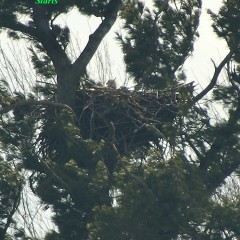 March 30, 2019-Positive signs of a successful hatch at Walborn Reservoir Eagle Nest have been observed. Volunteers report they saw what looked like a possible start to hatching with adults looking in
March 30, 2019-Positive signs of a successful hatch at Walborn Reservoir Eagle Nest have been observed. Volunteers report they saw what looked like a possible start to hatching with adults looking in
down in the nest one day and both adults feeding the next day. It could be one or two eaglets, we’ll know soon when a fuzzy head(s) pop up high enough to see.
Feb. 15, 2019- Good news from the Walborn eagle nest site on Marlboro Ave. in Alliance. Volunteer, Jim K., reports the following… “I saw what looked like possible incubating on the Feb. 14, but was not sure. On Feb. 15, I can confirm that incubation has started. This will give a hatch date around March 22!” It takes 3 to 5 days for an egg to develop and 35 days to hatch. Eaglets will hatch 3 to 5 days apart when there is more than one egg. There will always be an adult present during incubation. Both parents will help in incubating the eggs and trade off at times while the other one hunts for food.
June 29, 2018- During the evening of June 26, we saw the fledgling fly a large circle from the nest tree twice. It sure didn’t look like a first flight with the great landings. We should start seeing it in the dead tree on the north side of the reservoir to the east of the nest. This is one of the places where the adults perch and watch for fish. The fledgling will watch the adults and learn how to hunt. Mom and dad will continue to feed it for a while longer until it can catch its own food. It will probably hang around here for a few more weeks before heading out. Most of Ohio’s young eagles go to the western basin area of Lake Erie because food and open areas are plentiful. It will work to improve flying and hunting skills for about three years. Most will return to within 50 to 100 miles of where they fledged from around that time. The head will start turning white at about four years and be completely white at five years of age.
June 15, 2018- The juvenile eaglet is over 11 weeks old. It has been flapping and hopping a lot to strengthen its wings. The baby fat will turn into muscle and it should fly any time now. Mom and dad have done a great job raising it. At about 15 weeks of age, nature will tell them it is time to head out, most likely to the western basin of Lake Erie. After three years, it will return to around 50 and 100 miles of where it fledged from. It has been another great year at the observation area and we are thankful for the friends we have made this season. It isn’t over yet though. Eagles are around this year throughout the year.
May 14, 2018- The eaglet is about seven weeks old now and is really developing fast. It is starting to develop feathers and will soon start hopping and flapping it’s wings. This motion will help build strength as it grows. Mom and dad are doing a great job keeping a continuous food supply for the eaglet. It needs the equivalent of one large fish each day. This is the thirteenth year for this nest which has now produced 22 young. That is an impressive average!
Did you know? An eagle can fly as high as 10,000 feet and can see a mouse from 1,000 feet in a grassy field.
April 30, 2018- The eaglet is about 4.50 weeks old. It is getting all the food it needs and growing fast. It will often stand up and will try to stretch its wings. The gray and fuzzy look will be replaced with feather in a few weeks. Adult eagles have around 7,000 feathers.It is about a 20 weeks from when the egg is laid until the eaglet is ready to leave the nest. This includes five weeks for the egg to hatch. Flying can come as early as eleven weeks, but it is historically a week or two after that at this nest. An average eagle is 35″ to 39″ long with a wing span of 72″ to 90″. Females tend to be a little larger than males. It is thought that this might give the male a little more maneuverability to fight and to hunt in wooded areas.
April 14, 2018- We are happy to announce the arrival of one eaglet for the 2018 season. The hatch date was March 28, 2018.
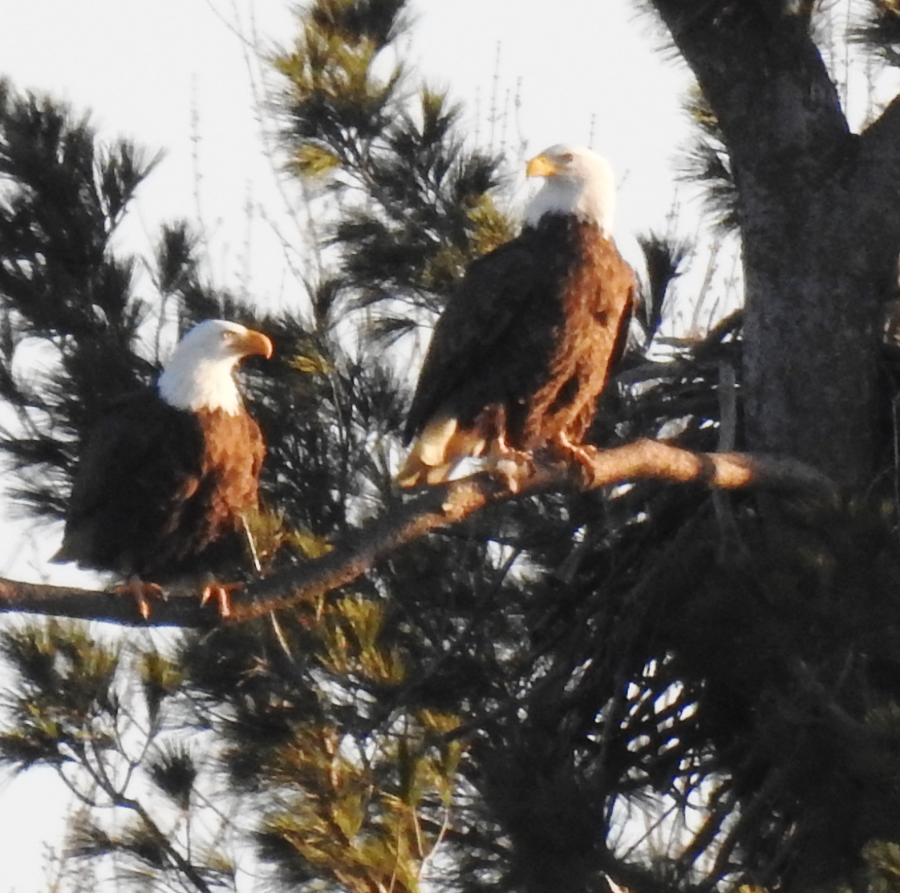 Feb. 16, 2018- It looks like incubation started on Feb. 15, the earliest we have seen at the nest by two days. An eagle was first observed in the nest about 1:45 p.m. on Thursday. After three follow up visits, it appears to be the start of incubation. This gives an approximate hatch date on March 22, 2018. We observe their behavior to determine when they lay an egg. They hardly ever lay down in the nest, except to incubate eggs. We watch to see if they get up and poke around in the nest. This indicates that they are rolling the eggs. Then you watch to see if they waddle down and cover the eggs. They will trade off in shifts sitting in the nest. This is an exciting time for those of us that watch the eagles on a regular basis and new and returning visitors too! There will be activity at the nest for at least the next 20 weeks while the young hatch and grow. It is an awesome thing to witness!
Feb. 16, 2018- It looks like incubation started on Feb. 15, the earliest we have seen at the nest by two days. An eagle was first observed in the nest about 1:45 p.m. on Thursday. After three follow up visits, it appears to be the start of incubation. This gives an approximate hatch date on March 22, 2018. We observe their behavior to determine when they lay an egg. They hardly ever lay down in the nest, except to incubate eggs. We watch to see if they get up and poke around in the nest. This indicates that they are rolling the eggs. Then you watch to see if they waddle down and cover the eggs. They will trade off in shifts sitting in the nest. This is an exciting time for those of us that watch the eagles on a regular basis and new and returning visitors too! There will be activity at the nest for at least the next 20 weeks while the young hatch and grow. It is an awesome thing to witness!
Feb. 1, 2018- We are looking forward to the 13th nesting season for the eagle nest at Walborn Reservoir. The first 12 years have provided 21 eaglets and thousands of awe-struck reactions from visitors. The nest is becoming more active with signs of courting behavior. Eagles add to their nest each year and bring sticks and grass to the nest. This will help keep the young warm during cold periods.
Incubation has started as early as Feb. 17 and as late as March 8 over the years. Hatches have occurred as early as March 26 and as late as April 15.
Once egg(s) are laid, there will always be an eagle present at the nest.
The female will do the majority of the incubation and the male will be doing most of the hunting. The male will relieve the female so that she can get exercise and groom herself. Ohio estimates to have over two hundred nests. Some are in areas that no one would have ever imagined!
July 11, 2017- The fledglings are about 15 weeks old and have been flying for a few weeks. They may stay around the nest for six to nine weeks once they have flown. They will continue to watch their parents to hone their own hunting and flying skills. The parents will continue to provide occasional food while they are still here.
All three of the young haven’t been seen
at the same time since June 15. They like to perch on the nearby electric poles.
Their beak and eyes will gradually turn yellow and it will take four to five years for the head and tail feathers to turn white to indicate their maturity.
June 23, 2017- All three of the eaglets have now fledged. The first at 10 weeks and the last at 11.50 weeks of age. They are almost 12 weeks old and are really doing very well. Mom and Dad did an excellent job of taking care of these three eaglets. When there are three in a nest, it is common that one will die of starvation.
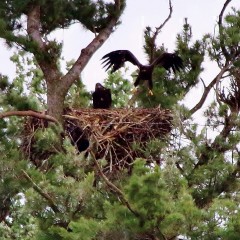 The eaglets will stay in the area for a few more weeks watching what the parents hunt and improving their flying and landing skills. The parents will continue to provide food until they can start hunting on their own. Their baby fat is turning into muscle and they are getting stronger each day. At around 15 weeks of age, nature will tell them when and where to head to. Most young eagles in Ohio go to the western basin area of Lake Erie. They will generally return to between 50 and 100 miles of their fledging area in about three years.
The eaglets will stay in the area for a few more weeks watching what the parents hunt and improving their flying and landing skills. The parents will continue to provide food until they can start hunting on their own. Their baby fat is turning into muscle and they are getting stronger each day. At around 15 weeks of age, nature will tell them when and where to head to. Most young eagles in Ohio go to the western basin area of Lake Erie. They will generally return to between 50 and 100 miles of their fledging area in about three years.
It has been another great eagle watching year at the deck. It is not over, just transitioning into the next phase. We see eagles during the year, so please stop by and visit.
One of the parents has been landing in the area below the nest and taking food to it. As the eaglet gains strength it might come back up the nest tree. They will watch their parents to learn how to catch their own food. They will find low branches to perch on until they can fly back up to the trees.
June 8, 2017- The eaglets are making great progress, maybe even ahead of schedule, and are now over 10 weeks old. We had one leave the nest around June 2 or June 3. It was right at 10 weeks old and that is the earliest fledge we have seen at this nest. We usually see a fledge between 11 and 13 weeks of age.
One of the parents has been landing in the area below the nest and taking food to it. As the eaglet gains strength it might come back up the nest tree. They will watch their parents to learn how to catch their own food. They will find low branches to perch on until they can fly back up to the trees.June 3, 2017- The Walborn Reservoir eaglets are 9 weeks old and growing really fast!
Their parents stay busy providing the food so it is hard to say what time of day is best to see the most activity. The eaglets have been hopping and flapping their wings a lot to develop their muscles. They should start flying in 3 or 4 weeks (they usually fly between 12 and 14 weeks old). They will be hopping out on a limb soon to gain confidence. The parents can leave them alone now that they have their feathers and are larger.
May 16, 2017- The eaglets are about seven weeks old now and mom and dad are doing an excellent job of taking care of them. Three eaglets is a lot of responsibility and work! They appear to be very healthy and active with a never ending appetite.
They are starting to exercise their wings and are hopping around. They eat, rest for a bit, and then eat again. They require about one large fish per eagle/per day. You will notice a slight difference in their sizes. They probably hatched a few days apart from first hatch to third hatch.
Plan on seeing a lot of activity at the nest for the next few months. It will be a lot of work for the parents to keep them fed. Luckily there is a steady food supply in and around the reservoir.
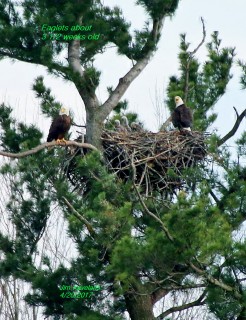 April 7, 2017- An already exciting time around the Walborn nest just got even more so! After a few days of close observation following the hatch of two eaglets, Volunteer Jim K. confirmed there was another head visible. That means there are three eaglets in the nest. This is the first time this nest has been home to three eaglets in a hatch and brings the total to 21 eaglets from the nest over the last 12 years.
April 7, 2017- An already exciting time around the Walborn nest just got even more so! After a few days of close observation following the hatch of two eaglets, Volunteer Jim K. confirmed there was another head visible. That means there are three eaglets in the nest. This is the first time this nest has been home to three eaglets in a hatch and brings the total to 21 eaglets from the nest over the last 12 years.
Plan on seeing a lot of activity at the nest for the next few months. It will be a lot of work for the parents to keep them fed. Luckily there is a steady food supply in and around the reservoir.
February 17, 2017- At some point between noon on Feb. 16 and 9:30 a.m. on Feb. 17, an egg was laid at the Walborn Eagle nest. At 9:30 a.m. I saw mom standing in the nest and poking around. A few minutes later she waddled down. At 10 a.m. the male flew in and mom stood and flew off. Dad poked around and then settled down and pulled grass towards him.
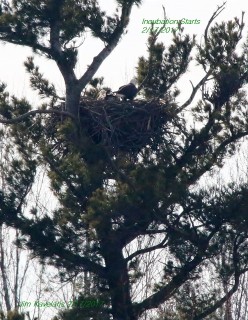 This is the earliest start time at the nest site. Incubation began on Feb. 19 in 2006. The estimated hatch date is March 24, 2017. Let’s hope for more than one eaglet!
This is the earliest start time at the nest site. Incubation began on Feb. 19 in 2006. The estimated hatch date is March 24, 2017. Let’s hope for more than one eaglet!
This is the 12th year for the nest with 18 young fledging from the nest over that time.
This is the 5th year for the original male and this female. (The original female disappeared in 2013) The new female arrived shortly after we lost the original female, but was unable to produce any eggs that year. She has produced 5 young.
July 17, 2016- It has been another great year of watching nature in action. Ohio’s Eagle population has soared over the past few years, with well over two hundred nests in Ohio compared to only four in 1979.
It is hard to say how much longer the juvenile will stay in the area. Look all around as they can be perched anywhere including other areas at Walborn and Deer Creek Reservoirs.
I have enjoyed making new friends while watching the eagles. Many purchased your own spotting scopes and are so willing to share them with others. This is exactly how I got started watching them too! Many thanks to Bob and Bonnie for your time and energy volunteering here too. Thank you to Cliff for your pictures and sharing your scope and knowledge with others.
I am honored to have a fan club in Pamela and Patrick and thanks for sponsoring the new bench. It is awesome to sit on and enjoy what nature provides. Many visitors will enjoy this for a long time to come.
We have spoken with over 1,000 visitors at the deck this year and there have been many stop by when we were not here. Looking forwarding to the 2017 edition of the Walborn eagle nest!
June 22, 2016- The Juvenile is 12½ weeks old now and right on schedule in development. Last Friday evening was the first time the juvenile was out of the nest and on a limb.
Tuesday evening, we saw the juvenile on the North side of the lake perched on a low branch of a dead Willow tree directly below the nest site. Hopefully, we will still see it in the area, as it watches its parents to learn how to catch its own food and sharpen its flying and landing skills. In the past, we have seen the juvenile back at the nest site a few days after its first time of leaving it.We should be able to see it for a few more weeks before it heads out on its own.
Most of Ohio’s young Eagles go to the western basin of Lake Erie.
They stay there for about three years while they develop and learn from watching other Eagles. They generally return to within 50 to a 100 miles of their birth nest site. Eventually they will pair up with a mate and start their own nest.
June 9, 2016- The juvenile is about eleven weeks old and is doing a lot of wing stretching and hopping. It almost looks bored at times and will pick up sticks and play with a catfish head in the nest. It will start to venture out on a limb to gain confidence and flap its wings.
The first flight should happen soon, anytime from 11.50 week old to around 13 weeks old. We may not see it for a few days after the flight.
Sometimes they just circle the nest tree and land back at the nest, but other times they might land on the ground or in another tree. The parents will coax it to come to them by flying by with food.
Eventually it will perch on limbs along the shoreline watching the parents catch fish.
We have always seen the young stay in this area for a few weeks after they begin flying. It will most likely leave the area in late July or August. Most of Ohio’s young eagles go to the western basin area of Lake Erie. They join other immature eagles and stay there for about three years. During this time they sharpen their flying and hunting skills.
Did you know that a bald eagle can fly as high as 10,000 feet reaching level flight speeds of 30 to 35 miles per hour?
May 17, 2016- The eaglet is about seven weeks old now and developing feathers.
The parents have been leaving it alone for short periods for the last couple of weeks, but you can bet that one of them is close by. It’s appetite will increase as it gets bigger putting more pressure on the parents to keep a good supply of food coming. The evenings are the best time to see the eaglet getting fed, but it does eat every couple of hours.
It is stretching and hopping time in the nest, every little breeze triggers something that makes it want to keep trying to fly.
A few younger eagles are still hanging around the area this year. They look to be between 3 years and 5 years of age. An eagle gets its white head around five years of age, but you can also guess their age by the color of the beak. It is dark at birth and turns yellow as it gets older.
Did you know that an eagle has about 7,000 feathers? They are layered and have different purposes. They can fluff them up and even rotate them to help keep them warm or cool. Nature sure is amazing! Volunteer Jim K., reporting from the Walborn Eagle Nest at 13600 Marlboro Avenue NE in Alliance. Come out and visit.
April 21, 2016- It looks like there will be just one eaglet this year. That makes 18 young eagles from this nest site over eleven years. I saw some early feeding behavior that made me think there might be two, but I am thankful for whatever nature gives us.
We have developed a following of visitors at the observation deck, I appreciate Bob and Bonnie volunteering at the site. We really enjoy seeing the visitor reactions after their first glance through the spotting scope. Some folks are even buying their own scopes and sharing the views with new visitors. They even have my speech memorized they have heard it so many times, this hobby is contagious!
We continue to see JUVS (eagles that are one to five years old before they get their white head) in the area. Osprey have also been frequent flyers around Walborn Reservoir.
April 14, 2016- The Walborn Eagle nest site was the place to be in Alliance on Thursday night. Here is how volunteer eagle watcher, Jim K., explained it!
“I went down to set up at 5:20pm and had several people waiting. While watching someone said there is another large bird in a tree about 200 yards to the east of the nest tree. We all started looking, I relocated my spotting scope, and what we saw was amazing . There were 5 juvenile eagles all perched in the tree. One head is almost white and the male eagle kept chasing this more mature one away.
Mom actually went over and perched with the juveniles for a bit and then went back to the nest. It was remarkable to see 7 eagles in one spot. One man came over and said that he had been on Reeder Ave. and could see two more lower in the tree that we could not see from the deck area. Who needs Alaska!”
April 5, 2016- It looks like there were two hatches last week, around March 26 and March 31. Both parents appear to be feeding at the same time on two different sightings. This is a strong indicator that we have two eaglets, but we will know for sure when the fuzzy heads start popping up in the next week or so. The 2016 hatch was 17 days earlier than the 2015 hatch.
Expect a lot of activity at the nest site for the next three months. Enjoy your visit and remember to not go beyond the observation deck.
Scopes will be set up most evenings weather permitting. Volunteer eagle watchers Bob, Bonnie, and Jim look forward to sharing their eagle knowledge with you.
March 15, 2016- The adult eagles seem to be doing just fine. One of them is always on the nest with an occasional trade off once in a while.
The female does around 85% of the incubating while the male will do most of the hunting. It will be this way until the young are around 6 weeks old and start to get some feathers to help keep them warm. As they get bigger and want more food, it will take both parents to keep up with their demands. By seven or eight weeks the parents will leave them alone for short periods while they hunt.
We should see signs of a hatch around Easter weekend. You can tell if there was a hatch by watching the parents and see if they are eating and giving the young small pieces of food. Watch closely to see if they are passing food in more than one location and you might be able to tell how many eaglets! By the end of the second week of April ,we should be able to see the eaglets moving around. They look prehistoric at this age, covered with a light grey down. It will be replaced with a darker grey which will start being replaced by feathers at about six weeks.
Feb. 22, 2016– It looks like incubation started on Feb. 20 around 3 p.m.
Volunteer Naturalists witnessed what appeared to be the female Eagle laying an egg. After observing the eagle for a little while longer, they were able to confirm that the female is incubating. (No way to know how many eggs though) Eagles lay their eggs a few days apart with incubation lasting 25 days. A hatch should occur around March 26, give or take a day or two. An average of 20 weeks goes by from the time the eggs are laid to when the young eagles leave the nest.
Over the last 11 years, the earliest incubation was on Feb. 19, 2006 and the latest was last year, March 8, 2015. Eagles can have between 1 and 3 eggs taking 3 to 5 days for an egg to develop. Ohio Eagles average 1.7 per nest and ironically so does the Walborn nest.
For the next five weeks we will see the eagles head and back above the sticks in the nest. The male will bring in food and trade off with the female to give her a break. The Eagles will move around and turn the eggs about every hour and will never leave the nest for more than a few minutes.
Feb. 3, 2016– 2016 marks the 11th season for the popular nest. It produced 17 young over the first 10 years.
It appears that the courtship started in early January probably due in part to the warmer weather. The first indication was on Jan. 4 when both eagles were making repairs to the nest. Late January brought consistent sightings of both eagles at the nest. We hope to report incubation behaviors happening in the nest soon.
The observation deck area had some upgrades made since last fall including a new entrance sign from Marlboro Ave. and an improved trail from the driveway to the deck.
Sept. 7, 2015- It looks like the two juvenile eagles have headed out on their own. The last sighting was Aug. 20, they might be around the area somewhere or maybe the western Lake Erie basin.
Aug. 3, 2015-The eaglets are celebrating their sweet 16th birthday (in weeks). One of them has been spotted on a limb with a small fish in its talon.
They will continue watching their parents to learn and develop their own hunting skills, the parents will not let them go hungry but will gradually stop providing food. At some point, they will head out on their own most likely to the western basin of Lake Erie. They can continue to watch other eagles and learn from them with plenty of fish in the water to hunt.
July 18, 2015–The two young eagles are about 14 weeks old and developing the hunting and instincts to survive. They will not be at the nest nearly as much so seeing them can be a challenge. Sometimes they are perching in the trees along the shore line with the parents close by. They will observe their parents to learn how to hunt their own food. The parents will continue to provide food to help them survive for a little longer.
It is hard to estimate just how long they will stay around here. Nature is an awesome thing and very hard to predict. Most of Ohio’s young Eagles go to the western basin area of Lake Erie. There is not an explanation for how they know to go there. There are a lot more open areas for them to develop their flying and hunting skills in that area.
At around 2.50 years old they will return to the general area they fledged from and settle within a 50 to 100 mile radius. An eagle gets its white head at around 5 years old and can live to be 25 to 30 years old.
Ohio now has over 200 known eagle nests. 341 eaglets were counted in 2014 from those 200 nests throughout Ohio.
July 3, 2015–The two juvenile eagles are 11 weeks old. Both of them were out on the limb yesterday. Expect to see them walking on limbs and hopping in and out of the nest. The parents will continue to provide food for them while they develop their own flying and hunting skills. They learn everything by watching their parents.
They should be flying in the next two weeks and hopefully hang out at the nest tree for a while. It is entertaining to watch them fly out of the nest and circle back as they build confidence.
A widened parking lot was installed with a new trail leading to the observation deck.
June 19, 2015–The two juveniles are ten weeks old and continue to grow up fast. Mom and dad are busy hunting for food to satisfy their growing appetite. They will be alone at the nest more often while the parents are hunting.
The adults might be perched in the trees on the shoreline out of sight. It’s worth the wait to see them fly over, it is just hard to predict when they are going to come in and feed. Late evening seems to be a good time though.
They are doing a lot of wing stretching and hopping, this helps to strengthen their wings and prepare them for their first flight. It looks like they are frustrated and just want to take off, but it must be an awesome feeling to them. When I watch them through the spotting scope I always feel like they are looking right back at me.
They should start to fly by the middle of July.
June 6, 2015–Entering the eight week old mark, the two juvenile eagles continue to grow and eat more. They can regulate their own body temperature, stretch their wings a lot, and will go out on the tree limbs to flap their wings.
Their first flight should be around the thirteenth week or about July 15. They should be ready to leave the nest by week 15 at the end of July.
On average an adult Eagle is about three feet (beak to tail feathers). They have a wing span from 72 to 90 inches. They can fly to an altitude of 10,000 feet and reach speeds of 30 to 35 mph.
May 22, 2015–The two young eaglets are 5 to 6 weeks old and should be developing their secondary feathers. (An eagle has about 7,000 feathers!) Their appetite will increase along with their size, the growth each week is really noticeable!
You might see some wing stretching happening on your next visit. The parents will start to leave them for periods of time since they are able to regulate their own body temperature. The adults will be busy finding food and feeding the two eaglets.
May 12, 2015–The two Eaglets are about 4 weeks old. They are starting to get their secondary feathers and will change from fuzzy little eaglets to darker feathered birds. They are around one foot tall and will soon begin to stand and stretching their wings.
They will be near full size in another eight weeks. At six weeks they will be able to regulate their own body temp and won’t need mom to cover them as much. She will still protect them from too much sun or rain.
Activity in and around the nest will increase. The eaglets appetite increases with their size. Mom and dad will be busy trying to provide one large fish a day for each bird.
The ten year old nest has produced 17 total eaglets.
April 20, 2015–Signs of a hatch were first observed April 15 with the female feeding at least one eaglet. On May 1, 2015 two eaglet heads were spotted.
Osprey in the area have been pretty active too with many reported sightings. They are a little smaller than an eagle and eat only fish.
They have a white head and under side with a brown band around their head . They nest on top of poles and utility towers in the area. Their wings are thinner than an eagle and they fly with a full stroke.
You might catch eagle watching volunteer, Jim K., at the Observation Deck on Tuesday and Thursday evenings from 6 to 8 p.m. and some Saturday and Sunday afternoons from 3 to 6 p.m.
March 10, 2015–Volunteer Eagle Watcher, Jim K., observed the following last weekend: “The behavior of the two adult eagles had me guessing for a few days, but I am certain that there is at least one egg in the nest. On Friday evening I saw the female eating a lot. On Saturday the female left the nest several times for a period of time but some courtship activities were taking place. Sunday and Monday brought more consistent signs of incubation with egg turning and the female eagle changing positions in the nest. “Eggs are laid a few days apart, it usually takes 5 to 10 days to develop. It takes about 35 days for eggs to hatch which will be around April 12.January 12, 2015–2015 marks the tenth year for the Walborn Reservoir nest. Both adult eagles were spotted at the nest together for the first time this year on the morning of January 11. It looks like they have been working to add sticks to the nest.
Entering into the courtship and new breeding season, one eagle flew off and returned twenty minutes later with food. The pair typically begins incubation in late February or early March, the eggs take 35 days to hatch usually the last week of March or first week of April.
Fifeteen eagles fledged from this site during the last nine years. We lost the original female in 2013, the new young female came to the nest a few days after the disappearance and successfully paired up with the male. Although too late in the mating season for 2013, the pair produced two young eaglets in 2014.
October 14, 2014–October usually doesn’t bring many eagle updates because the young have gone and the adults are in their routine. A little twist this year has been a juvenile eagle hanging around the nest. Our volunteer eagle expert, Jim K., says it could be from this year but he believes it is about three years old and might have been from this nest. (Offspring of the previous female adult eagle and current male adult eagle) We can only speculate where it came from, but seeing three eagles at the site is interesting.
July 21, 2014–The 15-week old juvenile eagles are doing what is expected at this stage in their development; flying around and searching for food. The parents are still helping them with food though.
Last Sunday evening the male adult baited one of the young by dropping a fish into the nest.
As a juvenile was coming in to get it, the female adult picked it up and pulled it across the nest. The juvenile grabbed it and covered it with it’s wings until the mother backed away from it . When the second juvenile came in, it once again covered it to keep it protected. This is a good sign in their development.
I have noticed a lot of activity in the evenings after 6:30 p.m. On my last two visits, I have seen them come in to the nest between 7 and 8 p.m. I will continue to stop by in the evenings on Sundays, Tuesdays, and Thursdays as long the juveniles in the area. Bring bug spray if you come out in the evenings to watch!
June 30, 2014–The two young eagles are 12 weeks old and have been doing a lot of wing stretching, hopping, and limb walking. Most young eagles fly between 11 and 13 weeks, so it will happen at any time. We should continue to see them in the area for a few more weeks before they venture out on their own.
Most of the young hang out on the nest tree, but sometimes can be found closer to the water on low branches. A good place to look is in the trees near the power lines if you do not see them in the nest tree.
June 20, 2014–The two juveniles are about 11 weeks old now and have been doing a lot of wing stretching and hopping in the nest. They should start going out on the tree limbs soon and start flying in the next two weeks.
The parents will continue to provide the food, but no longer need to feed it to the juveniles. Later in the summer they will leave the nest. It is common to see young eagles in the western basin of Lake Erie where it is easier to find food. They can also improve their flying and landing skills. A recent news ODNR news release reported 200 eagle nests in Ohio with an estimate of 350 eaglets in 2014.
May 15, 2014–The two young eaglets are about 6 weeks old and doing great, they are about a foot tall and are growing their feathers. They should be hopping and stretching their wings in the nest soon. They should be eating at least one large fish each day to continue growing.
May 9, 2014–The eaglets are five weeks old and enjoying the fish being brought to the nest.
April 28, 2014– Two eaglets are in the nest and there is a lot of activity around it. A total of 15 eaglets have come out of this nest in the last 8 years. Look for Jim K. there at 6 p.m. on Thursday nights and from 3 to 6 p.m. on Sundays during May.
April 7, 2014– At least one eaglet has hatched and is being fed, we’ll know how many eaglets are in the nest in about two weeks.
March 3, 2014— Jim emailed, “I am sure that there are eggs in the nest now. On Feb. 27 I saw what looked like an egg turning and then on Saturday the adult eagles traded off and on the nest.” Jim is predicting a hatch around April 3.
December 16, 2013– Volunteer Eagle watcher, Jim K., stopped by the Walborn Reservoir nest site twice today. No sign of them at 9 a.m., but both eagles were perched on the limb around 1 p.m. He expects them to start working on their nest more over the next few weeks and become a little more active.
August 28, 2013– An established pair of eagles has been observed again at Walborn Reservoir. The pair has bonded with continued activity around the nest site. The new female is on the left and the original male with the brighter white head is on the right. Early evening seems to be best time to see them.
May 10, 2013– For six of the last seven years, the eagles at Walborn Reservoir have produced chicks-a total of 13 eaglets. In 2013 a new female eagle appeared. There is no way to know what happened to her predecessor, but no eggs were produced at this nest this spring. Consequently, the eagles’ visitation to the nest is sporadic and unpredictable. While you may be lucky enough to see one of them flying around Walborn or Deer Creek Reservoirs, their flight range can be quite large.
Posted on March 1, 2024 within News, Parks, Volunteers
Recent Posts
Derby Circuit-Spring and Summer 2024 Kids (Ages 4-15) can join the 2024 fishing derby circuit and participate in free fishing derbies from April to August. Sponsored by Stark County Federation… More
Project Overview Stark Parks is hoping to add a new water trailhead along the Tuscarawas River in the city of Canal Fulton located at 232 Market St W through an… More
Stark Parks celebrated volunteer accomplishments in 2023 at the annual Volunteer Recognition Dinner at the Exploration Gateway at Sippo Lake Park earlier this month. Through September, over 14,000 volunteer hours… More
A new Stark Parks logo is being debuted to better reflect the park mission and create more consistency throughout the organization. The last true redesign occurred over 25 years ago when… More
Stark Parks, in cooperation with the Ohio Department of Transportation (ODOT), invites the public to provide comments regarding the proposed replacement of a 13'-10" long timber bridge structure (Sippo Valley… More
Beginning in March 2023, Stark Parks crews will begin preparing areas at Tam O'Shanter Park for parking lot and driveway updates including removing and relocating trees and vegetation. Construction will… More
We hope you enjoy the observations of eagle watching volunteers and invite you to stop by the nest site located on the west side of Walborn Reservoir at 13600 Marlboro… More
Geocaching is a great way to explore Stark Parks year-round! Find the hidden caches at different park locations and collect 12 out of 15 code words to win a unique… More
